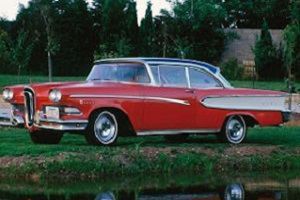Edsel was an exercise in corporate buccaneering that rapidly became a byword for failure. The venture proved an expensive fiasco for Ford (it lost $350 million), and the resultant cars were extraordinary for their very ordinariness.

Edsel Pacer 1957
- YEAR REVEALED 1957
- PLACE OF ORIGIN Detroit, Michigan
- HISTORICAL STATUS production car
- ENGINE V8-cylinder, 361ci (5,915cc)
- MAXIMUM POWER 304bhp
- LAYOUT front-mounted engine driving the rear wheels
- BODYWORK five-seater sedan and four-seater convertible
- TOP SPEED 105mph (169kph)
- NUMBER BUILT 19,057
The idea for the brand came from Ford’s conclusion that it was being outpaced by arch-rival General Motors and its five US marques. Ford decided to install another division between the basic Ford range and the sports-luxury Mercury. In 1955, it hired poet Marianne Moore for her linguistic expertise to find a new name for it. “Intelligent Whale” and “Utopian Turtletop” were both mooted before the new company section was called Edsel, after Henry Ford’s late son.
Early ideas for a completely new car were abandoned on cost grounds, and a cocktail of existing engines, driveline, and bodywork was assembled-Ford parts for the cheaper Pacer/Ranger range, Mercury components for the pricier Citation/Corsair. Distinctive Edsel touches included a vertical front grille shaped like a horse collar, and a “Teletouch” push-button gearchange in the steering wheel.
Launched in a TV spectacular hosted by Bing Crosby, the 13-car range sold sluggishly from the start. The break-even sales point was 650 cars daily, but averaged about 300. The reasons were complex: sales of large, thirsty cars like Edsels were decimated by imports and compact models; quality was mediocre; Ford dealer support half-hearted; and the public underwhelmed.